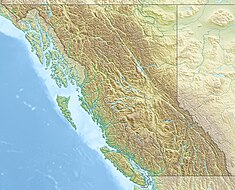| Site C | |
|---|---|
 Dam construction as of April 2017 | |
| Official name | Site C Project |
| Location | British Columbia, Canada |
| Coordinates | 56°11′41″N 120°54′51″W / 56.19472°N 120.91417°W |
| Status | Under construction |
| Opening date | 2025 (planned) |
| Construction cost | C$16 billion, February 2021 estimate |
| Owner(s) | BC Hydro |
| Dam and spillways | |
| Type of dam | Earth fill[1] |
| Impounds | Peace River |
| Height | 60 m (200 ft)[1] |
| Length | 1,050 m (3,440 ft)[1] |
| Reservoir | |
| Surface area | 9,330 ha (23,100 acres)[1] |
| Power Station | |
| Installed capacity | 1,100 MW[2] |
| Annual generation | 4,600 GWh[1] |
The Site C Dam is a hydroelectric dam currently under construction on the Peace River, 14 kilometers southwest of Fort St. John in northeastern British Columbia, Canada. It is located approximately 80 kilometers downstream from the W. A. C. Bennett Dam. When completed in 2025, it will become the fourth largest producer of hydroelectricity in British Columbia, with an expected capacity of 1,100[2] MW and an expected annual output of 4,600 GWh of electricity.[1][3][4]
A publicly accessible viewpoint is located immediately west of the City of Fort St. John, on the south side of Highway 97.[5]
The project has drawn considerable opposition from several quarters due to its planned flooding of agricultural land, damage to the local environment, high construction cost, possible alternatives, and the uncertainty of future electricity prices and demand in the province. Two Treaty 8 First Nations and local landowners have made legal challenges to the dam, though these were dismissed by the Federal Court of Appeal.[6][7] In addition, over 200 scholars, as well as the Royal Society of Canada, have expressed concerns to the federal Liberal government, citing weakness in the regulatory review process and the environmental assessment for the project.[8][9] In May 2016, the federal government of Canada stated it is "not revisiting projects that have been reviewed and approved".[10] On 11 December 2017, John Horgan, the premier of British Columbia, announced: "We've come to a conclusion that, although Site C is not the project we would have favoured or would have started, it must be completed",[11] thus guaranteeing the completion of the project.
- ^ a b c d e f "Backgrounder: About Site C" (PDF). BC Hydro. Archived from the original (PDF) on 23 June 2016. Retrieved 4 February 2016.
- ^ a b "Site C Clean Energy Project".
- ^ "Province announces Site C Clean Energy Project". BC Hydro. 19 April 2010. Retrieved 26 April 2010.
- ^ "Site C Backgrounder" (PDF). BC Hydro. 23 June 2016. Archived from the original (PDF) on 23 June 2016. Retrieved 29 April 2018.
- ^ "Visit the Site C viewpoint". BC Hydro. Retrieved 4 June 2022.
- ^ Gillis, Damien (22 April 2015). "Landowners launch Site C Dam court challenge, First Nations next". Common Sense Canadian. Archived from the original on 30 May 2015. Retrieved 26 June 2015.
- ^ "Federal Court of Appeal dismisses First Nations' challenge of B.C.'s Site C dam". The Globe and Mail. Retrieved 21 April 2017.
- ^ Site C: Statement by Concerned Scholars, Program of Water Governance, University of British Columbia. Retrieved 22 June 2016
- ^ Cheadle, Bruce (24 May 2016). "Royal Society of Canada, academics, call Site C dam a test for Trudeau Liberals". CTV News. The Canadian Press. Retrieved 22 June 2016.
- ^ McCarthy, Shawn (24 May 2016). "Ottawa pushes ahead with Site C dam amid opposition from academics". The Globe and Mail. Retrieved 22 June 2016.
- ^ McElroy, Justin (11 December 2017). "B.C. government to go ahead with Site C hydroelectric dam project". CBC News. Retrieved 11 December 2017.
